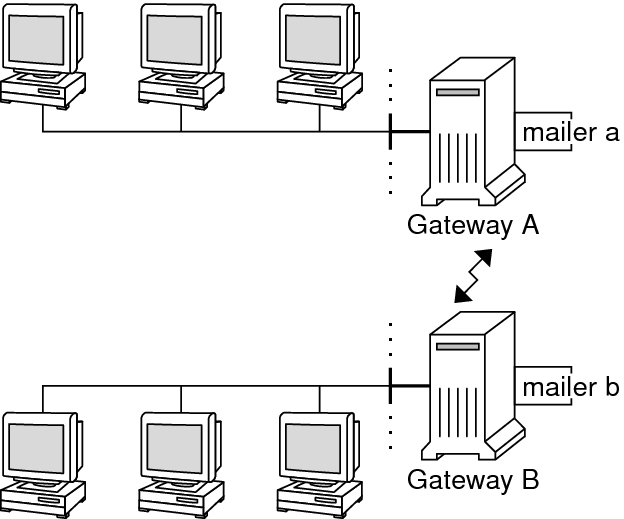Hardware Components for Mail Configurations
A mail configuration requires certain hardware components to be present either on the same system or on separate systems: a mail host, a mail server, a mail client, and a mail gateway.
Mail Host
A mail host is the primary component on your network to which other systems forward mail that cannot be delivered. You can designate a system as a mail host in the hosts database by adding the word mailhost to the right of the IP address in the local /etc/hosts file. Alternatively, you can add the word mailhost to the hosts file in the name service.
A good candidate for a mail host is a system that is configured as a router on your network and connects to the Internet. For more information, see Configuring an IPv4 Router in Configuring an Oracle Solaris 11.3 System as a Router or a Load Balancer.
Some sites use standalone machines that are not networked in a time-sharing configuration. Specifically, the standalone system serves terminals that are attached to its serial ports. You can set up email for the configuration by designating the standalone system as the mail host of a single-system network.
Mail Server
A mailbox is a file that stores email for a particular user. Mail is delivered to the user's mailbox where the mailbox is located either on a local system or on a remote server. A mail server maintains user mailboxes using the /var/mail directory.
The mail server routes all mail from a mail client. When a mail client sends a mail message, the mail server puts the message in the queue for delivery. After the message is in the queue, the sender can reboot or turn off the mail client without losing it. If the recipient responds, the response goes to the sender's mailbox. Good candidates for mail servers are systems that provide a home directory for users, or systems that are backed up regularly.
If the mail server is not the user's local system, users in a configuration that uses NFS software can mount the /var/mail directory provided the user has administrator privileges. Otherwise, the user can use the automounter to mount the /var/mail directory. If NFS support is not available, the user can log in to the server to read mail.
If users on your network typically send messages with attachments, such as audio files or files from desktop publishing systems, you might need to allocate more space on the mail server for mailboxes.
By establishing a mail server for all mailboxes, you can simplify your process of creating backups. The disadvantage of storing many mailboxes on one mail server is that the server can be a single point of failure for many users. However, the advantage of creating backups usually makes the risk worthwhile.
Mail Client
A mail client uses mail services and has a mailbox that is present on a mail server. Additionally, the mail client has a mail alias in the /etc/mail/aliases file that points to the location of the mailbox.
Mail Gateway
The mail gateway handles connections between networks. Networks can use either different communication protocols or the same communication protocol. For example, a mail gateway might connect a TCP/IP network to a network that uses the Systems Network Architecture (SNA) protocol suite.
A mail gateway connecting two networks that use the same protocol or mailer is easy to set up. The mail gateway handles mail in your domain sent to recipients that the sendmail program cannot find. If a mail gateway exists, sendmail uses the gateway to send and receive mail outside your domain.
The following figure shows a mail gateway between two networks that use unmatched mailers.
Figure 2 Gateway Between Different Communication Protocols

To support this configuration, you must customize the sendmail.cf file on the mail gateway system.
If you have a system that connects to the Internet, you can configure that system as the mail gateway. Carefully consider your site's security needs before you configure a mail gateway. You might need to create a firewall gateway between your corporate network and other networks.